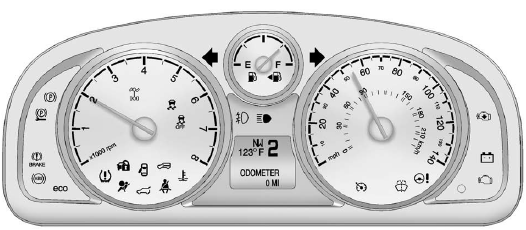Chevrolet Captiva Owners Manual: Warning Lights, Gauges, and Indicators
Warning lights and gauges can signal that something is wrong before it becomes serious enough to cause an expensive repair or replacement. Paying attention to the warning lights and gauges could prevent injury.
Warning lights come on when there could be a problem with a vehicle function. Some warning lights come on briefly when the engine is started to indicate they are working.
Gauges can indicate when there could be a problem with a vehicle function. Often gauges and warning lights work together to indicate a problem with the vehicle.
When one of the warning lights comes on and stays on while driving, or when one of the gauges shows there may be a problem, check the section that explains what to do. Follow this manual's advice.
Waiting to do repairs can be costly and even dangerous
Instrument Cluster

English Cluster Shown, Metric Cluster Similar
Speedometer
The speedometer shows the vehicle's speed in either kilometers per hour (km/h) or miles per hour (mph).
Understanding the warning lights, gauges, and indicators on your Chevrolet Captiva (2006-2018) is crucial for maintaining vehicle health and safety. These visual cues provide valuable information about various systems and components, alerting you to potential issues or the need for action. For instance, the check engine light signifies problems with the engine or emission control system, while the oil pressure warning light warns of low oil pressure that could lead to engine damage. Familiarizing yourself with these warning lights, gauges, and indicators empowers you to respond effectively to maintain your Chevrolet Captiva's (C100, C140) performance and safety standards.
- Odometer, Trip Odometer
- Fuel Gauge
- Safety Belt Reminders, Airbag Readiness Light
- Passenger Airbag Status Indicator, Charging System Light
- Malfunction Indicator Lamp
- Service Vehicle Soon Light, Brake System Warning Light
- Electric Parking Brake Light, Antilock Brake System (ABS) Warning Light
- All-Wheel-Drive Light, Power Steering Warning Light
- StabiliTrak® Indicator Light, Traction Control System (TCS) Warning Light, Engine Coolant Temperature Warning Light
- Tire Pressure Light
- Fuel Economy Light, Low Fuel Warning Light, Security Light
- Reduced Engine Power Light, High-Beam On Light, Front Fog Lamp Light
- Cruise Control Light, Gate Ajar Light
 Power Outlets
Power Outlets
The accessory power outlets can be
used to plug in electrical equipment,
such as a cell phone or MP3 player.
The power outlets are inside the
center floor console, on the rear of
the center flo ...
 Odometer, Trip Odometer
Odometer, Trip Odometer
Odometer
The odometer shows how far the vehicle has been driven, in either kilometers or miles.
This vehicle has a tamper-resistant odometer. If the vehicle needs a new odometer installed, the new ...
More about:
Chevrolet Captiva Service & Repair Manual > Brakes: ABS Control Module R&R
Caution: Always connect or disconnect the wiring harness connector from the EBCM/EBTCM with the ignition switch in the OFF position. Failure to observe this precaution could result in damage to the EBCM/EBTCM.
ABS Control Module Removal
...
Chevrolet Captiva Owners Manual
- Introduction
- In Brief
- Keys, Doors, and Windows
- Seats and Restraints
- Storage
- Instruments and Controls
- Lighting
- Infotainment System
- Climate Controls
- Driving and Operating
- Vehicle Care
- Service and Maintenance
- Technical Data
- OnStar
